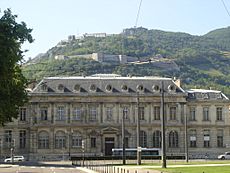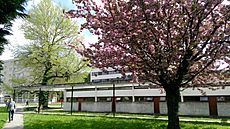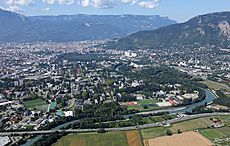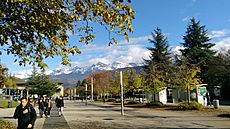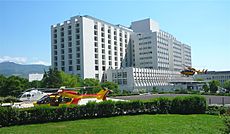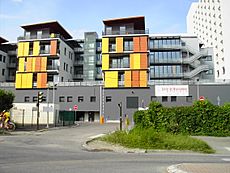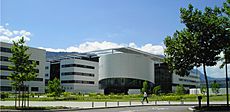Grenoble Alpes University facts for kids
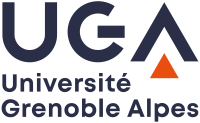 |
|
|
Former name
|
University of Grenoble (1339–1970), UPMF & UJF & Stendhal (1971–2015) |
|---|---|
| Motto |
Veritas Liberabit
|
|
Motto in English
|
The truth shall set you free |
| Type | Public |
| Established | 1339 |
| Founder | Humbert II of Viennois |
| Budget | €450 million |
| President | Yassine Lakhnech |
|
Academic staff
|
3,000 |
|
Administrative staff
|
2,500 |
| Students | 60,000 (2020) |
| Location |
Cities of Grenoble, Saint-Martin-d'Hères & Gières
,
in France
|
| Campus | Urban/College town 432 acres (175 ha) |
| Affiliations | Aurora, EUA, AUF, SGroup |
The Université Grenoble Alpes (also called Grenoble Alps University, or UGA) is a very important university in Grenoble, France. It was started way back in 1339. Today, it is the third largest university in France. About 60,000 students study there, and over 3,000 researchers work there.
The university was first known as the University of Grenoble. It was founded by Humbert II of Viennois. In 1970, after some big student protests in May 1968, the university split into several smaller parts. Later, in 2016, three of these parts—Joseph Fourier University, Pierre Mendès-France University, and Stendhal University—joined back together. They decided to use the original name, Université Grenoble Alpes. In 2020, even more schools joined, like the Grenoble Institute of Technology and the Grenoble School of Architecture.
The university has two main campuses close to each other. One is called Domaine Universitaire, and the other is Campus GIANT in Grenoble. UGA also has buildings in other cities like Valence and Chambéry.
Grenoble is a major science hub in Europe. Many research places in France are located there. This means UGA works with hundreds of research groups. They work closely with big organizations like the French National Centre for Scientific Research (CNRS). Grenoble is the second largest research center in France, after Paris. In 2019, UGA was chosen to host one of France's four special institutes for artificial intelligence.
Contents
History of the University
How the University Began (1339–1800)
The University of Grenoble was founded on May 12, 1339. It was started by Humbert II of Viennois. He was the last independent ruler of a state called Dauphiné. The university was created to teach law, medicine, and liberal arts. It was seen as a leader in bringing back classic studies during the Renaissance.
Humbert was inspired by his granduncle, Robert, King of Naples. King Robert was known as "the Wise." He made Naples a beautiful city and supported many artists and thinkers. Humbert wanted to create a similar place of learning in his own state. He even visited Pope Benedict XII to get his approval.
Humbert really cared about his students. He offered them help and protection. He even gave free housing to a hundred students. However, Humbert lost a lot of money during some wars. Also, a terrible disease called the Black Death spread. These problems, and his state joining France, made the university's activities slow down. It eventually closed because the small town couldn't support it alone.
The university reopened in 1475 in Valence. This was done by Louis XI of France. The original university in Grenoble was brought back in 1542. This was thanks to Francis de Bourbon, Count of St. Pol. The two universities finally joined together in 1565. At that time, Grenoble was an important place for law in France. So, law studies were a big part of the university's education.
During the French Revolution, many universities in France were closed. Revolutionaries thought universities were old-fashioned and held too much power. Also, the land owned by universities was taken, just like property owned by the Church.
Modern Times (1800–1968)
Between 1805 and 1808, Napoleon brought back the faculties (departments) of law, letters, and science. For a short time, the Bourbon rulers closed some faculties. But by the 1850s, the university started growing quickly again.
Science studies at the university grew a lot. This happened because Grenoble became a big center for making industrial motors and electrical equipment in the 1880s. The different departments officially became the University of Grenoble in 1879. They moved into new buildings in Place de Verdun. By 1930, there were about 3,000 students. In the 1960s, many more students joined. This put pressure on the university's buildings. The Suzanne Dobelmann library helped by adding more space, especially for science and medicine.
Recent History (1968–Present)
After the May 1968 events in France, many French universities changed. Between 1968 and 1971, the University of Grenoble was divided into four separate schools:
- Grenoble 1: Focused on science and medicine, later called Joseph Fourier University.
- Grenoble 2: Focused on social sciences, later called Pierre Mendès-France University.Lua error in Module:Wd at line 1571: attempt to index field 'wikibase' (a nil value).
- Grenoble 3: Focused on languages and literature, later called Stendhal University.
- The Grenoble Institute of Technology (Grenoble INP).
In 2013, people started talking about joining the universities in Grenoble again. Joseph Fourier University, Pierre Mendès-France University, and Stendhal University merged on January 1, 2016. They became the Université Grenoble Alpes.
On January 1, 2020, even more schools joined. The Grenoble Institute of Technology (Grenoble-INP), the Grenoble Institute of Political Studies, and the Grenoble School of Architecture all merged with the University Grenoble Alpes.
In November 2023, the French Parliament gave the university a special status. This made it a "grand établissement," which means it's a very important public institution.
University Campuses
UGA's main buildings are in the Grenoble area. They are mostly on the Domaine Universitaire campus, the GIANT campus, and the La Tronche medical campus. But there are also many other buildings in and around Grenoble. This includes the Valence campus and many research labs.
Domaine Universitaire (Grenoble)
The Domaine Universitaire is the main UGA campus. It covers a huge area of 175 hectares (about 432 acres). It's like its own little town within the Grenoble area. Most of the university's teaching buildings and many research labs are here. Olivier-Clément Cacoub designed some important buildings, like the science library.
This campus is special because it's a separate area just for school and student activities. This is different from most French universities, where buildings are spread out in the city. This design was an experiment in the 1960s to help the fast-growing university. Because of this, it's sometimes called an "American campus."
The campus has 3,000 trees, including a special garden with over 250 different types of trees. It's surrounded by the Isère (river) and close to three mountain ranges. This makes it a beautiful place to study. The university is known as one of the most beautiful campuses in France and Europe. It's easy to get around the campus with trams, buses, and bike paths. Grenoble is also known as one of the best student cities in France.
The La Tronche campus is just one tram stop from Domaine Universitaire. It focuses on medical studies. It is also home to the Grenoble Alpes University Hospital.
Campus GIANT (Grenoble)
Campus GIANT stands for "Grenoble Innovation for Advanced New Technologies." It's a campus where many different organizations work together. It's located on an old military area between two rivers, the Isère and the Drac. This area is called Polygone Scientifique. The GIANT Campus has several schools, especially parts of UGA (like INPG) and the Grenoble School of Management. Big government research groups like CNRS and CEA are also here.
The GIANT campus is home to Minatec, a center for tiny technologies. It also has large European research tools like the European Synchrotron Radiation Facility. Many big companies, such as Schneider Electric, also have offices on this campus.
Unlike the Domaine Universitaire, which has many different subjects, the GIANT Campus focuses more on science and technology. It helps researchers and companies work together.
Other Locations
The university also has buildings outside the main campuses.
- An alpine botanical garden called Jardin botanique alpin du Lautaret covers 2 hectares (about 5 acres). It's located high up in the mountains.
- A department for managing companies is run in Vienne.
- A center for farming research is located in Ardèche.
How the University is Run
The Université Grenoble Alpes is a public institution. It is managed by a board of directors and an academic council. These groups are chosen every four years. The president of the university is chosen by the board. On December 3, 2015, students and staff voted for representatives for the new university. On January 7, 2016, Lise Dumasy was chosen as president. She was the first woman to lead a merged university in France.
The university was a main member of the Community Université Grenoble Alpes. This group helped different parts of the university system in Grenoble work together.
On January 1, 2020, this group merged with the university. The Grenoble Institute of Technology, the Grenoble Institute of Political Studies, and the Grenoble School of Architecture also joined. Yassine Lakhnech became the president of the newly merged university. He was re-elected on January 11, 2024. However, there were some issues with the elections. After new elections in April 2024, Yassine Lakhnech was elected president again on May 16, 2024, for four more years.
What Students Learn
| University rankings | |
|---|---|
| Université Grenoble Alpes | |
| Global – Overall | |
| ARWU World | 101–150 (2023) |
| QS World | 321 (2026) |
| Reuters World | 91 (2019) |
| THE World | 301–350 (2024) |
| USNWR Global | 186 (2023) |
The Université Grenoble Alpes has many different departments, schools, and institutes. Here are some of the main areas of study:
- Science Faculties:
* Chemistry and Biology * Computer Science, Mathematics, and Applied Mathematics (IM2AG) * Physics, Engineering, Earth & Environmental Sciences, Mechanics (PhITEM) * Grenoble Observatory for Sciences of the Universe (OSUG) * Undergraduate Science and Technology (DLST)
- Grenoble INP (Engineering Schools):
* Energy, Water, and Environmental Sciences (Ense3) * Applied Mathematics and Computer Science (Ensimag) * Advanced Systems and Networks (Esisar) * Industrial Engineering and Management * Paper, Print Media, and Biomaterials (Pagora) * Physics, Electronics, and Materials Science (Phelma) * Graduate School of Management (Grenoble IAE) * Polytechnic Engineering School (Polytech Grenoble)
- Humanities, Health, Sports, Society (H3S) Faculties:
* Arts and Humanities (ARSH) * Foreign Languages (LE) * Languages, Literature, Performing Arts, Information, and Communication (LLASIC) * Humanities and Social Sciences (SHS) * Physical and Sports Activities (STAPS) * Medicine * Pharmacology
- Other Faculties and Departments:
* Institute of Urban Planning and Alpine Geography (IUGA) * Grenoble Law School * Grenoble Faculty of Economics
- Grenoble Institute of Political Studies (Sciences Po Grenoble)
- Grenoble School of Architecture (ENSAG)
- University Institutes of Technology (IUTs):
* IUT Grenoble 1 * IUT Grenoble 2 * IUT de Valence
- Other Important Centers:
* Drôme Ardèche Department of Sciences (DSDA) * University Centre for French Studies (CUEF) * Institute of Education and Teaching (INSPE) * Languages Office (SDL) * Doctoral College (for PhD students)
Research at UGA
The Université Grenoble Alpes has 106 research departments. These are grouped into six main centers, covering all kinds of subjects. These centers bring together different types of research teams and labs.
- Humanities and Social Science Centre (Pôle SHS)
- Chemistry, Biology, and Health Centre (Pôle CBS)
- Mathematics, Information, and Communication Sciences and Technologies Centre (Pôle MSTIC)
- Particle Physics, Astrophysics, Geosciences, Environment, and Ecology Centre (Pôle PAGE)
- Physics, Engineering, and Materials Centre (Pôle PEM)
- Social Sciences Centre (Pôle SS)
Many research labs are connected to the university. Through Grenoble INP, the university helped start Minatec. This is an international center for micro-nano technologies. Over 3,000 researchers and 1,200 students work there.
The university also hosts one of France's four national Institutes of Artificial Intelligence.
If you want to get a PhD (a very high-level degree), the Doctoral College helps manage this. It sets the rules for UGA's 13 doctoral schools.
Famous People from UGA
Many famous people have studied at UGA. They come from different fields, like academics, politics, business, and art.
Political Leaders
Many European politicians have studied law, economics, and languages at UGA. These include Reinhold Maier, Helene Weber, Walther Schreiber, and Michel Destot.
Other important political leaders who studied here are:
- Gaétan Barrette, a Minister from Canada.
- Paul Kaba Thieba, a Prime Minister from Burkina Faso.
- Abderrahmane Benkhalfa, a Minister from Algeria.
- Hazem El Beblawi, a Prime Minister from Egypt.
- Abdoulaye Wade, a President from Senegal.
- Bill Morneau, a Minister from Canada.
- Souvanna Phouma, a Prime Minister from Laos.
UGA alumni also include journalists like Warren D. Leary from America and Mélissa Theuriau from France. Some social activists, like Léo-Paul Lauzon and Léa Roback, also attended UGA.
Scientists and Mathematicians
Many important scientists have studied at the Université Grenoble Alpes. This has been especially true since the 1880s, when hydropower developed in the region. Important fields include physics, material sciences, and computer sciences. Some notable alumni are:
- Yves Bréchet, a member of the French Academy of Sciences.
- Rajaâ Cherkaoui El Moursli, who worked on the discovery of the Higgs Boson.
- Joseph Sifakis, who won the Turing Award for computer science.
- Gérard Mourou, who won the Nobel Prize.
- Jean-Jacques Favier, an astronaut.
- Charles Elachi, a director at NASA's Jet Propulsion Laboratory.
- Alim Louis Benabid, a neurosurgeon.
See also
 In Spanish: Universidad de Grenoble para niños
In Spanish: Universidad de Grenoble para niños




